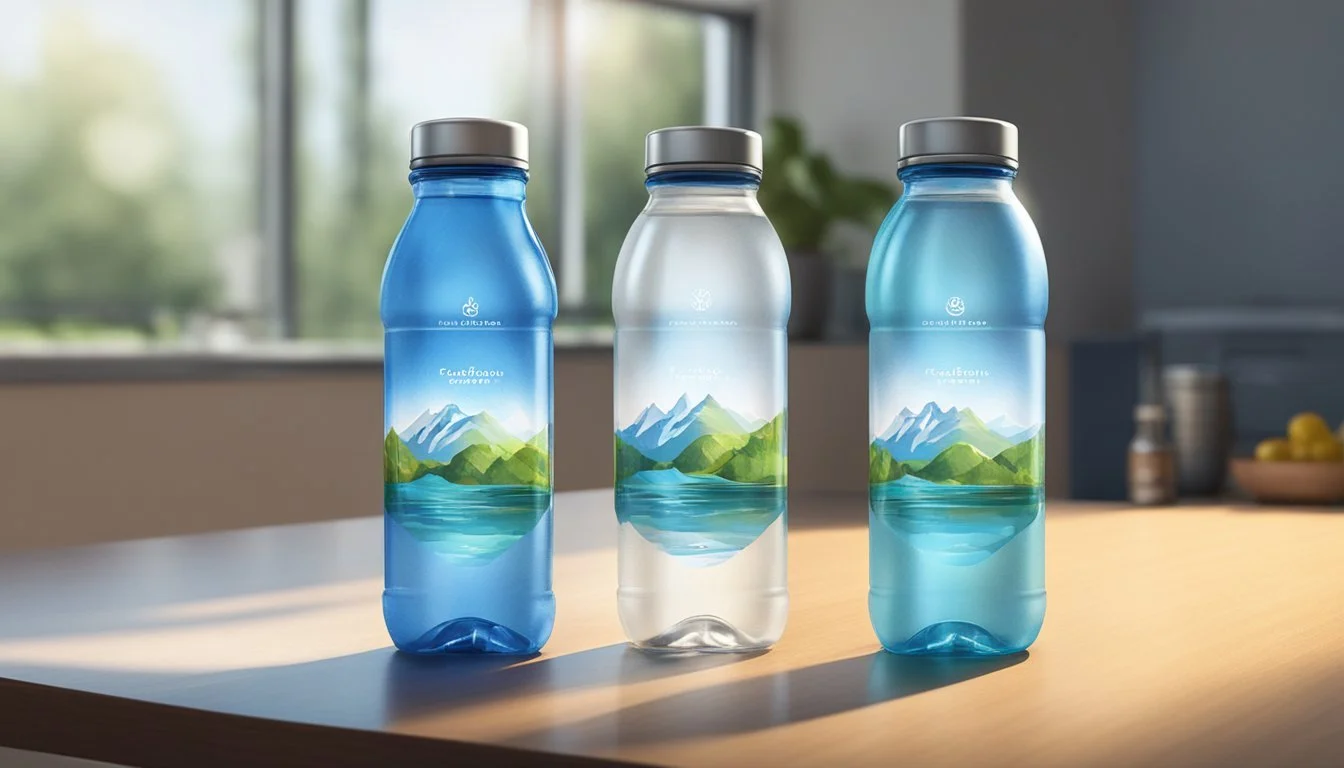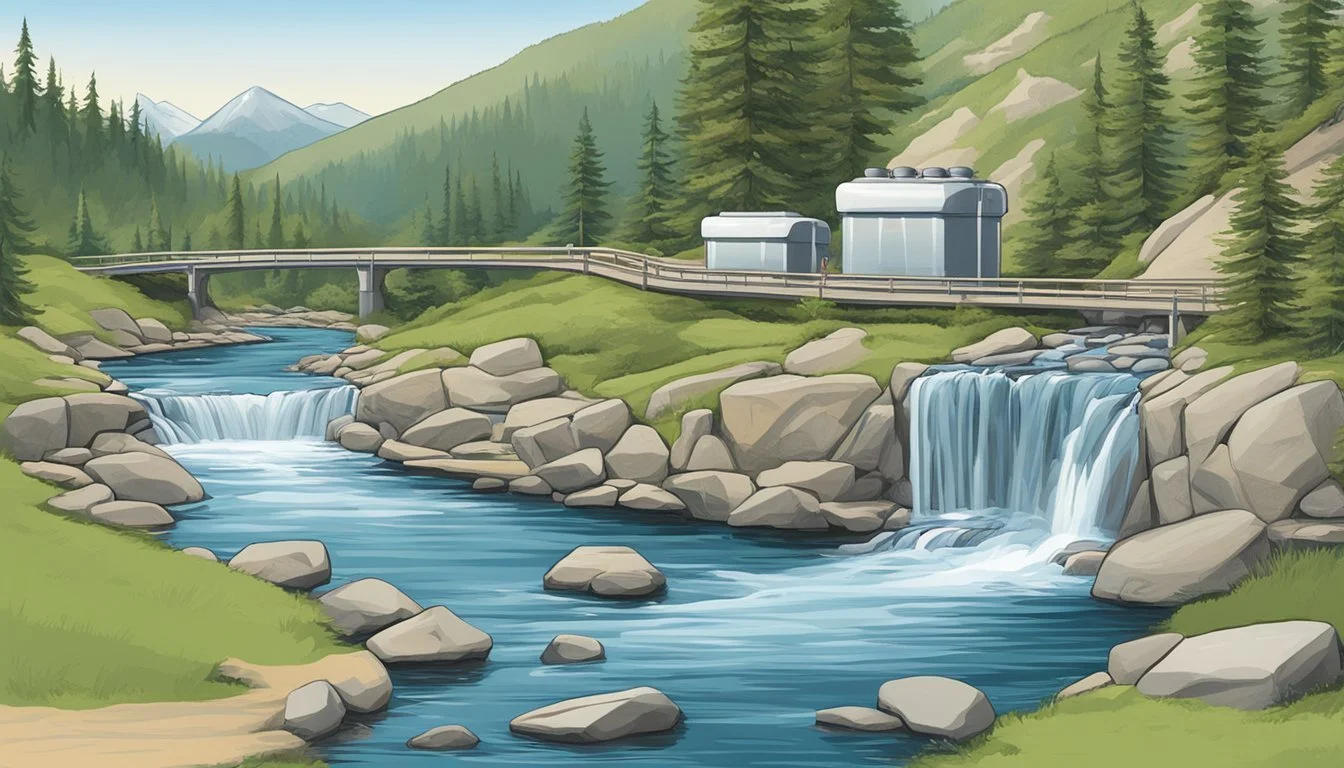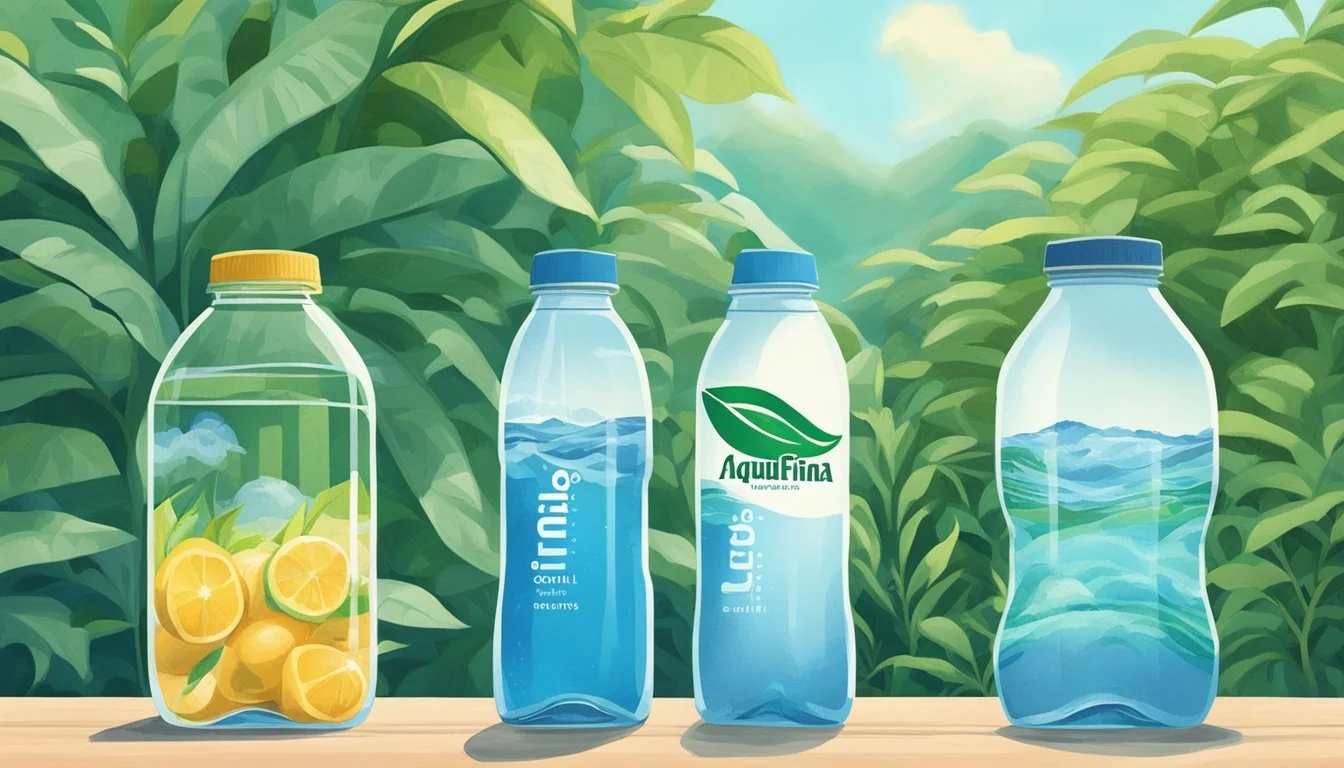Aquafina vs. Big Chill
Which Bottled Water is Better for You?
When it comes to choosing between Aquafina and Big Chill bottled waters, it’s essential to know what sets each brand apart. Aquafina, a product of PepsiCo, boasts a purification process that aims to deliver crisp and refreshing water, free from impurities. On the other hand, Big Chill is recognized for sourcing water from natural springs, emphasizing a pure and natural taste.
For those prioritizing purity, Aquafina's rigorous purification process might make it the more appealing option. Big Chill, with its spring-sourced origins, often appeals to consumers who value a mineral-rich, natural water profile.
Both brands have their unique advantages, which ultimately come down to personal preference. Whether you lean towards the enhanced purification of Aquafina or the natural sourcing of Big Chill, having a clear understanding of each can guide you to a better choice for your hydration needs.
Understanding Bottled Water
Consumers often choose bottled water for its convenience and perceived higher quality over tap water. This section explores the various types available and the labeling and regulations governing them.
Types of Bottled Water
There are several categories of bottled water, each with distinct characteristics:
Purified Water: Purified through processes like reverse osmosis or distillation, ensuring it is free from impurities and contaminants. Popular brands include Aquafina and Dasani.
Spring Water: Sourced from natural springs, it is collected where water flows to the earth’s surface. Often marketed as natural, it retains naturally occurring minerals. Brands like Deer Park and Arrowhead fall into this category.
Mineral Water: Contains specific amounts of minerals such as calcium and magnesium, sourced from mineral springs. These minerals must be naturally present and not added during processing. Perrier and San Pellegrino are well-known mineral waters.
Alkaline Water: Has a higher pH level, often achieved through ionization or adding alkalizing compounds. It's touted for potential health benefits, including improved hydration.
Vapor-Distilled Water: Produced by evaporating water and then condensing the steam, removing most contaminants and minerals, resulting in extremely pure water. Smartwater, by Coca-Cola, is an example of this type.
Labeling and Regulations
Bottled water labeling and regulations are critical for ensuring the safety and quality of the product:
FDA Regulations: In the United States, the FDA regulates bottled water under the Federal Food, Drug, and Cosmetic Act. This ensures all bottled waters meet specific safety and labeling standards.
EPA Standards: While the EPA oversees tap water, their standards influence bottled water regulations, striving to ensure comparable safety levels.
Labeling Requirements: Labels must clearly indicate the type of water, source, and treatment used. This transparency helps consumers make informed choices. Terms like "natural spring water" or "purified water" must meet strict definitions.
Mineral Content and Electrolytes: Labels often highlight the presence of beneficial minerals and electrolytes, such as calcium and potassium, which can influence taste and hydration benefits.
Marketing Claims: Brands may promote specific qualities, such as pH level, alkalinity, or unique filtration processes. These claims must be substantiated to avoid misleading consumers. For instance, Aquafina emphasizes its seven-step HydRO-7 purification process.
Regulations and clear labeling are vital to maintaining consumer trust and ensuring product safety.
Water Source and Filtration
The quality of bottled water largely depends on the source of the water and the filtration methods used. In this section, the origin and purification processes for both Aquafina and Big Chill bottled waters are examined thoroughly.
Aquafina: Pure Water Filtration
Aquafina, owned by PepsiCo, is known for its rigorous purification methods. The principal source of Aquafina water is municipal tap water, which undergoes an extensive purification process.
Key Points:
Reverse Osmosis: Aquafina employs reverse osmosis to ensure the removal of impurities. This process forces water through a semi-permeable membrane, filtering out contaminants, minerals, and other particles.
Hydro-7 Filtration Process: In addition to reverse osmosis, Aquafina utilizes a proprietary seven-step filtration process known as Hydro-7. This comprehensive process ensures water purity and taste consistency.
Purity and Taste: The result of these methods is water that is described as clean and crisp without the presence of minerals that one might find in natural spring water.
The combination of these processes aims to produce bottled water that meets and often exceeds standard purity levels.
Big Chill: Source and Purity
Big Chill bottled water is sourced from natural springs, known for their high-quality and naturally filtered water.
Key Points:
Spring Water Source: Big Chill sources its water from underground springs. These springs are often located in mountainous areas where water naturally percolates through rocks.
Natural Filtration: As water travels through permeable layers of volcanic rock, it undergoes natural filtration. This process helps remove impurities while retaining beneficial minerals.
Mineral Content and Taste: The natural filtration through volcanic rock not only purifies Big Chill water but also adds a distinct mineral taste, which many consumers find appealing.
Big Chill emphasizes the natural origin and minimal processing of its water, aiming to maintain the purity and natural minerals in the final product.
Comparative Analysis of Taste and Quality
Aquafina and Big Chill bottled waters differ notably in taste and quality attributes such as purification methods, mineral content, and pH levels.
Flavor Profile
Aquafina undergoes a rigorous purification process involving reverse osmosis and several filtration stages. This method results in a clean, neutral taste with no noticeable aftertaste. It's designed to appeal to those who prefer a highly purified, crisp flavor without mineral interference.
In contrast, Big Chill is sourced from natural springs, introducing a more earthy, mineral-rich taste. Magnesium and calcium present in Big Chill contribute to a slightly structured flavor. The natural mineral content can make the water feel more robust on the palate compared to the more straightforward profile of Aquafina.
Health and Hydration Benefits
Aquafina's purified water lacks minerals, which might make it less beneficial for replenishing electrolytes compared to other brands. Being void of elements like potassium chloride, it's suitable for those seeking purely filtered water without any mineral additives.
Big Chill offers a complex mineral composition, including magnesium and calcium, essential for maintaining health. This mineral-rich profile supports better hydration and electrolyte balance, favoring those who need to replenish lost nutrients. Its pH level usually leans towards alkalinity, helping neutralize acidity in the body, which can be a health benefit for some consumers.
Aquafina generally maintains a neutral pH close to 7, making it suitable for daily consumption without altering the body's acid-base balance significantly. These factors illustrate clear distinctions in how each brand serves various consumer needs and preferences.
Environmental Impact and Sustainability
When comparing Aquafina and Big Chill, considering the environmental aspects and sustainability practices is vital. This includes looking at their bottling processes and the efforts each brand makes towards eco-friendly practices.
Bottling Process
Aquafina claims to use a 7-step HydRO-7 filtration process to purify its water, ensuring that fewer impurities remain.
Big Chill, on the other hand, focuses on local sourcing and aims to minimize the distance from the source to bottling plants. This approach can reduce the carbon footprint associated with transportation.
Both brands use plastic bottles, although there are plans to introduce recyclable and BPA-free packaging. The choice of materials in their bottling processes significantly impacts the product's overall environmental footprint.
Eco-Friendly Practices
Aquafina is part of PepsiCo, which has set a goal to make all product packaging recyclable, compostable, or biodegradable by 2025. They have started offering water in 12-ounce cans at food service outlets, reducing single-use plastic dependency.
Big Chill has initiated programs to promote recycling and sustainability. They encourage customers to return used bottles for proper recycling.
Both brands recognize the need to adapt eco-friendly practices to mitigate their environmental impacts. They are exploring the use of alternative packaging options such as boxed water to enhance their sustainability profile.
Consumer Preferences
Aquafina and Big Chill each have unique advantages that appeal to different segments of the market. Understanding the trends and factors that drive purchasing decisions will provide a clearer picture of why consumers might prefer one brand over the other.
Market Trends
The bottled water market has seen significant growth, driven by increased health consciousness and the convenience factor. Aquafina, associated with the PepsiCo brand, benefits from its extensive distribution network, ensuring high availability. On the other hand, Big Chill often appeals to consumers seeking affordable and locally produced options.
Brand loyalty plays a pivotal role in consumer behavior. Consumers tend to stick with brands they trust for quality and taste. Aquafina consistently ranks high for its clean, crisp taste and reliable quality. Big Chill's appeal lies in its price point and availability, making it a popular choice for cost-conscious buyers.
Market demand for bottled water continues to rise, and both brands have leveraged this by catering to different segments. Aquafina targets the premium market, while Big Chill focuses on affordability without compromising basic quality standards.
Purchasing Decisions
When deciding between Aquafina and Big Chill, several factors influence consumer choices. Taste is a primary factor; Aquafina's purification process ensures a neutral pH and consistent flavor, which appeals to those sensitive to mineral content variations. Big Chill offers a refreshing taste but may lack the enhanced purification that some consumers seek.
Price comparison is another crucial element. Aquafina generally holds a higher price point, justified by its brand reputation and superior filtration methods. Big Chill, with its lower cost, attracts those prioritizing value over brand prestige.
Availability and convenience are also essential. Aquafina’s wide distribution network means it’s found in most supermarkets and convenience stores, which can drive spur-of-the-moment purchases. Big Chill may not be as ubiquitously available, though it remains a staple in budget-friendly retail outlets.
Consumer reviews often highlight these points, with many praising Aquafina’s reliability and others appreciating Big Chill’s affordability. Both positive and negative feedback are echoed across social media and retail review platforms, influencing new buyers and shaping perceptions.
Health Considerations and Safety
When it comes to bottled water, evaluating chemical composition and adherence to safety standards is essential. Both Aquafina and Big Chill offer different purification methods, which influence their overall chemical profile and regulatory compliance.
Chemical Analysis
Aquafina employs a 7-step HydRO-7 filtration process, which is designed to remove impurities and contaminants. This meticulous method aims to eliminate substances that may still be present in other bottled waters. Aquafina adds mineral salts post-filtration, enhancing taste without compromising safety.
Big Chill, however, focuses on maintaining natural mineral content. The brand primarily utilizes natural filtration through spring water sources, which may include beneficial minerals like calcium and magnesium. This natural approach might impart a unique taste but requires careful monitoring to avoid any harmful contaminants.
pH levels are also a critical factor. Aquafina's pH typically falls between 5.5 and 7, reflecting its purified nature. Big Chill's pH can vary slightly depending on the source but generally remains neutral to slightly alkaline, which some believe to be better for balancing body acidity.
Contaminants like microplastics, free radicals, and other harmful substances are typically minimized in both brands. However, the precise filtration techniques and mineral additives can differ, affecting the final water quality. Testing results indicate both brands prioritize the removal of contaminants to ensure safety.
Regulatory Compliance
Aquafina and Big Chill must adhere to FDA and EPA regulations for bottled water safety. The FDA monitors the quality of bottled water to ensure it meets the same standards as tap water, if not higher. Aquafina ensures compliance by rigorous testing and quality control protocols, affirming that their purification process effectively removes harmful substances.
Big Chill, sourcing naturally, ensures their water meets or exceeds EPA standards, which are stringent for spring water. These regulations mandate regular testing for contaminants and maintenance of mineral balance. The natural filtration systems used by Big Chill must regularly confirm that their water is free from harmful chemicals and meets health safety standards.
Both brands effectively manage compliance with federal regulations, affirming that the water they provide is safe for consumption. The commitment to stringent safety standards ensures that both Aquafina and Big Chill offer reliable, safe drinking options to consumers.
By evaluating chemical composition and regulatory compliance, consumers can make an informed choice based on factual health considerations.
Final Verdict
Taste: Between Aquafina and Big Chill, taste preference plays a significant role. Aquafina is known for its consistent taste owing to its rigorous 7-step HydRO-7 filtration process. Big Chill, on the other hand, provides a more natural taste, appealing to those who prefer water with minimal processing.
Hydration: Both brands effectively hydrate, but Aquafina's stringent purification process may give some users peace of mind regarding water purity.
Purity: Aquafina’s advanced purification ensures minimal impurities. Big Chill offers a more natural experience, often sourcing from natural springs, which may contain natural minerals but lacks the extensive filtration of Aquafina.
Environmental Impact: Big Chill may have an edge with eco-friendly packaging. Aquafina, produced by PepsiCo, is widely available, but consumers might need to consider the environmental footprint of large-scale production and distribution.
Health Benefits: Aquafina's purified water is free from contaminants, ensuring safe consumption. Big Chill’s spring water can contain beneficial minerals unless it includes unwanted elements due to less rigorous filtration.
Aquafina vs Big Chill:
Factor Aquafina Big Chill Taste Consistent, filtered Natural, spring-like Purity Highly purified Natural mineral content Environmental Impact Traditional packaging Often eco-friendly options Health Benefits Free from impurities Contains natural minerals Price Value Widely affordable Regional variability
Price Value: Aquafina is widely affordable due to its extensive distribution network. Big Chill’s price can vary based on regional availability and distribution.
Choosing between Aquafina and Big Chill often comes down to personal preferences regarding taste, environmental concerns, and desired purity levels. Both provide reliable hydration, each with unique strengths.





